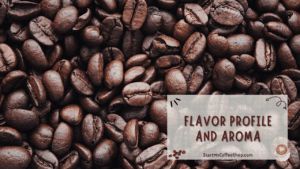Coffee has long been admired for its capacity to deliver a much-needed energy boost to launch our days or keep us going through those mid-afternoon slumps. Many of us seek out the richest flavors, the finest scents, and the most fulfilling caffeine kick while looking for the perfect cup of coffee. But, with so many coffee bean varieties available, which one reigns supreme in providing that much-needed energy boost?
To best satisfy your craving for a highly caffeinated coffee, you should choose Robusta beans as they outshine other popular coffee types by offering the highest caffeine content, almost double that of Arabica beans.
Understanding Robusta Beans

Scientifically referred to as Coffea canephora, robusta beans are a well-known variety of coffee prized for their potency and high caffeine content. With around 40% of the world’s coffee production coming from these beans, they have become an important part of the global coffee business. Robusta beans, which are native to central and western sub-Saharan Africa, have spread to farms on other continents, demonstrating their flexibility and versatility.
The flavor profile of Robusta beans is one of the main distinctions between them and their equivalent, Arabica beans. Robusta beans have a distinctively different flavor that is distinguished by a stronger bitterness and earthiness. Aside from offering a dramatic contrast to the delicate and nuanced aromas frequently associated with Arabica beans, these flavor notes give Robusta coffee its distinctive appeal. Those who prefer a stronger, more intense cup of coffee often select Robusta because of its bold flavor.
Robusta beans are well known for having a high caffeine concentration. Robusta beans typically have a caffeine concentration of 2.7%, which is nearly twice as much as Arabica beans. Robusta is the preferred coffee bean for those looking for an energizing and stimulating cup of joe because of its greater caffeine concentration, which results in a more intense stimulatory impact. The robustness of Robusta plants also adds to their appeal because, in comparison to Arabica plants, they are more resistant to diseases and pests, making them simpler to grow in a variety of climates.
Robusta beans are widely used in the coffee industry. They are frequently used in espresso blends because of their high caffeine level, which gives drinks a sharper kick and a deeper crema. Furthermore, Robusta beans are frequently used in the creation of instant coffee because of how strong they are, which helps preserve the coffee’s flavor integrity during processing and drying.
Read more about: Coffee Shop Start-Up Cost Spreadsheet: Financial Wisdom for Entrepreneurs
Caffeine Content: Robusta vs. Arabica
Robusta beans are the best when it comes to caffeine concentration. Robusta beans have about twice the amount of caffeine as Arabica beans, which normally range between 1.2% and 1.5%, with an average caffeine concentration of about 2.7%. For coffee drinkers looking for a strong caffeine boost, this striking disparity in caffeine concentration has important ramifications.
Coffee has invigorating properties since it contains caffeine, a natural stimulant. It affects the central nervous system, assisting in boosting alertness, enhancing focus, and reducing weariness. A cup of coffee made from Robusta beans will have a stronger stimulatory impact than one made from Arabica beans due to the higher caffeine concentration of these beans. This makes Robusta the favored option for people who want a robust and energizing cup of coffee to start their day off right or get through long workdays.
Numerous elements, such as genetic makeup, growing environments, and plant physiology, are responsible for the increased caffeine content in Robusta beans. Robusta plants typically flourish in places with lower elevations and harsher climatic conditions, like parts of Africa, Southeast Asia, and Brazil. The development of beans with greater caffeine content is influenced by these environmental conditions. Robusta plants have a faster metabolic rate, which causes the beans to produce more caffeine.
It’s vital to remember that coffee beans’ caffeine levels might vary, even within the same species. The amount of caffeine in a cup of coffee might vary depending on the size of the bean, the growing environment, and the processing techniques used. However, Robusta beans are typically more caffeinated than Arabica beans, making them the preferred option for those looking for a strong caffeine boost.
Robusta beans are a great choice for coffee lovers who desire a robust drink. Their higher quantities of caffeine ensure sharper wakefulness and more mental alertness. It’s important to keep in mind that everyone reacts to caffeine differently, and some people may be more sensitive to its side effects. It’s usually a good idea to drink coffee in moderation and to be conscious of your tolerance to the stimulant.
Cultivation and Growing Conditions
Robusta beans, which are renowned for their tenacity and adaptability, do well in areas with excellent growing circumstances that are lower in elevation. Robusta coffee bushes thrive in regions with warm climates and copious amounts of rainfall and are often found at elevations between sea level and 800 meters. Due to their favorable environmental conditions, nations like Vietnam, Brazil, and Indonesia are major producers of Robusta coffee.
These areas’ mild climates offer the range of temperatures needed for robusta coffee plants to thrive and grow. The ideal environment for the beans to flourish is one with constant warmth and high humidity. The plentiful rainfall guarantees that the coffee plants receive enough supply of water, which is essential for their development and general health.
The ability of Robusta beans to survive illnesses and pests better than other coffee varieties is one of their main advantages. These beans are tough, making them less susceptible to dangers like coffee rust and some pests that can harm farms. Robusta beans are a favored option for coffee farmers because of their durability, which lowers the possibility of large crop losses and enables more dependable production.
The areas that grow Robusta beans have built the infrastructure and knowledge to support their production. To increase the quality and output of Robusta coffee, they have invested in sustainable farming and processing techniques. The production of Robusta beans in these regions has grown to be a vital component of the regional economy, generating jobs and supporting the entire coffee sector.
In addition to having good growth conditions and being resistant to disease, Robusta beans have a unique flavor that some coffee lovers find appealing. In contrast to the subtle flavors of Arabica beans, which are frequently associated with a more bitter and earthy flavor, Robusta beans offer powerful, assertive flavors that have their special appeal. Because of this, Robusta is frequently used in coffee blends and preparations that call for a stronger flavor profile.
Flavor Profile and Aroma

Robusta beans, which are well-known for having a lot of caffeine, provide more than just a boost of energy. They have a peculiar flavor profile that entices coffee connoisseurs looking for strong, potent flavors. The flavor of Robusta is sometimes described as strong, full-bodied, and earthy; this distinguishes it from the more subtle flavors of Arabica beans.
When brewed, Robusta coffee exhibits its strong personality with a full-bodied, rich mouthfeel. The flavor profile has a strong base thanks to the distinct earthy overtones. There are undertones of chocolate and almonds that give the flavor depth and richness.
But it’s important to keep in mind that depending on their place of origin, how they’re processed, and how they’re roasted, Robusta beans can display a variety of flavor qualities. The terroir of the place where the beans are cultivated plays a role in the subtle flavor variations. The flavors that are produced from the beans can vary depending on the soil, climate, and altitude.
The flavor profile might also be affected by the processing techniques used after harvesting. The finished cup can differ slightly according to the processing method used, including natural (dry), washed (wet), or semi-washed. The flavor of Robusta coffee is significantly influenced by roast characteristics as well. Darker roasts can increase the powerful and robust features, enhancing the chocolate and nut overtones, while lighter roasts may highlight the bean’s natural acidity and brighter notes.
While some coffee lovers might favor the more subtle and nuanced flavors of Arabica beans, Robusta has a devoted following due to its robust and powerful flavor. Robusta offers a delicious and energizing cup for individuals who prefer a strong and intense cup of coffee. Robusta is a great option for espresso mixes because of its strong flavors and full-bodied character, which can withstand milk and produce a rich crema.
Read more about: Coffee Shop Start-up Cost: Breaking Down the Numbers
Applications and Blending
Because of their stronger flavor profile and higher caffeine concentration, robusta beans have become a staple in many different coffee blends and preparations. They are a favored option for achieving particular flavor profiles and improving the overall coffee experience because of their distinctive qualities.
Robusta beans are frequently used in espresso blends. They have a bigger kick thanks to their increased caffeine concentration, which is highly desired by espresso lovers seeking a stronger caffeine rush. Robusta beans also help to create the treasured crema, the fluffy coating of foam that sits atop an espresso shot. This creamy coating gives the espresso more depth and texture, which improves the visual and sensory aspects of sipping coffee.
The manufacture of instant coffee is another typical application for Robusta beans. The robustness of these beans is essential for preserving flavor integrity during the manufacture of instant coffee. Robusta beans’ strength and strong tastes make them better able to resist the methods required to turn them into soluble coffee granules. As a result, instant coffee keeps its distinctive flavor character and provides a quick and practical method to enjoy a strong cup of coffee on the go.
Robusta beans are commonly combined with other types of coffee to generate distinctive flavor profiles. By blending, coffee roasters can alter the flavor profile of their blends and include Robusta to give the finished product more body, strength, and depth. This kind of blending is especially well-liked for making espresso mixes since the strength of Robusta can help balance the tastes and make for a more enjoyable cup of espresso.
It’s crucial to remember that Robusta beans are used in many different coffee preparations for reasons more than just their high levels of caffeine and powerful flavors. Their incorporation in various coffee products is also influenced by additional factors, including cost, accessibility, and regional tastes.
Health Benefits and Considerations
Robusta beans offer possible health advantages of caffeine ingestion in addition to their high caffeine concentration. The effects of caffeine on alertness, cognitive function, and physical performance have all been connected. Caffeine is a useful ally for productivity and attention since it stimulates the central nervous system, which can assist fight exhaustion and encourage mental focus.
Frequent coffee drinking—including the consumption of Robusta coffee—has been linked to a lower risk of developing several diseases. According to studies, those who consume coffee had a lower risk of getting Parkinson’s disease, a neurodegenerative condition. Drinking coffee has been associated with a lower incidence of liver cirrhosis, a disease that causes damage to the liver.
It’s crucial to recognize that everyone reacts to coffee differently. When taking excessive amounts of caffeine, some people may be more sensitive to its effects and experience negative side effects such as insomnia, jitteriness, or an elevated heart rate. It’s important to eat coffee—including Robusta coffee—moderately and take into account individual tolerance levels. It’s crucial to understand one’s caffeine sensitivity and set limits depending on personal requirements and health considerations.
It is important to remember that the possible health advantages of drinking coffee go beyond its caffeine content. Coffee contains a variety of bioactive substances, such as polyphenols and antioxidants, which may help explain some of its potential health benefits. Including Robusta and Arabica beans, the precise makeup of these components can vary amongst different types of coffee.
Frequently Asked Questions

How does the caffeine content in Robusta beans compare to other popular coffee types?
Among popular coffee varieties, Robusta beans contain the most caffeine. Robusta beans are a great option for people looking for a highly caffeinated cup of coffee because they typically contain 2.7% caffeine, which is roughly twice as much as Arabica beans.
Are Robusta beans only used for their caffeine content?
Robusta beans are prized for their robust flavor profile in addition to their high caffeine level. The beans have a strong, earthy flavor with frequent undertones of chocolate and almonds. To give espresso blends a sharper kick and a deeper crema, robusta beans are frequently added. They are also widely used in instant coffees because of how robust they are in keeping the flavor of the coffee even after processing.
Are there any health considerations to keep in mind when consuming Robusta coffee?
Although Robusta coffee can provide a significant caffeine surge, it is important to use caution and take into account each person’s unique caffeine sensitivity. Overdosing caffeine can have negative effects like sleeplessness, jitteriness, and an elevated heart rate. Furthermore, individual health issues and responses to caffeine can differ, so it’s critical to pay attention to your body and modify your intake as necessary. A healthcare expert can offer specific recommendations regarding caffeine consumption.
To learn more on how to start your own coffee shop, check out my startup documents here.
Disclaimer: The information provided by StartMyCoffeeShop.com (“The Site”) is for general informational purposes only. All information on the Site is provided in good faith. However, we make no representation or warranty of any kind, express or implied, regarding the accuracy, adequacy, validity, reliability, availability, or completeness of any information on the Site. Under no circumstance shall we have any liability to you for any loss or damage of any kind incurred as a result of the use of the Site or Reliance on any information provided on the Site. Your use of the Site and reliance on any information on the Site is solely at your own risk. This blog post is for educational purposes only and does not constitute legal advice. Please consult a legal expert to address your specific needs. Terms and Conditions. (https://startmycoffeeshop.com/terms-and-conditions/)

Hi! I’m Shawn Chun
My adventure in coffee began when I first launched my first coffee shop back in the early 2000s. I had to figure out so many things on my own and to make it worse within 2 years of opening two large corporate coffee chains moved in just blocks away from me!
As I saw smaller and even some larger coffee shops in the neighborhood slowly lose customers to these giant coffee chains and slowly close up shop, I knew that I had to start getting creative…or go out of business.
I (like you may be) knew the coffee industry well. I could make the best latte art around and the foam on my caps was the fluffiest you have ever seen. I even had the best state-of-the-art 2 group digital Nuova Simonelli machine money could buy. But I knew that these things alone would not be enough to lure customers away from the name brand established coffee shops.
Eventually, through lots of trial and error as well as perseverance and creativity I did find a way to not only survive but also thrive in the coffee/espresso industry even while those corporate coffee chains stayed put. During those years I learned to adapt and always faced new challenges. It was not always easy, however, in the end, I was the sole survivor independent coffee shop within a 10-mile radius of my location. Just two corporate coffee chains and I were left after that year. All told the corporate coffee chains took down over 15 small independent coffee shops and kiosks and I was the last one standing and thriving.
Along the years I meet others with the same passion for coffee and I quickly learned that it is not only “how good a barista is” that makes a coffee shop successful, but the business side of coffee as well.
Hence why I started this website you are on now. To provide the tools and resources for up and coming coffee shop owners to gain that vital insight and knowledge on how to start a coffee shop successfully.
Stick around, browse through my helpful blog and resources and enjoy your stay! With lots of LATTE LOVE!
Shawn







